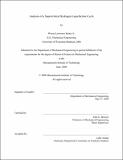Analysis of a supercritical hydrogen liquefaction cycle
Author(s)
Staats, Wayne Lawrence
DownloadFull printable version (2.144Mb)
Other Contributors
Massachusetts Institute of Technology. Dept. of Mechanical Engineering.
Advisor
John G. Brisson.
Terms of use
Metadata
Show full item recordAbstract
In this work, a supercritical hydrogen liquefaction cycle is proposed and analyzed numerically. If hydrogen is to be used as an energy carrier, the efficiency of liquefaction will become increasingly important. By examining some difficulties of commonly used industrial liquefaction cycles, several changes were suggested and a readily scalable, supercritical, helium-cooled hydrogen liquefaction cycle was proposed. A novel overlap in flow paths of the two coldest stages allowed the heat exchanger losses to be minimized and the use of a single-phase liquid expander eliminated the pressure reduction losses associated with a Joule-Thomson valve. A simulation program was written in MATLAB to investigate the effects of altering component efficiencies and various system parameters on the cycle efficiency. In addition to performing the overall cycle simulations, several of the system components were studied in greater detail. First, the required volume of the ortho-para catalyst beds was estimated based on published experimental data. Next, the improvement in cycle efficiency due to the use of a single-phase liquid expander to reduce the pressure of the hydrogen stream was estimated. Finally, a heat exchanger simulation program was developed to verify the feasibility and to estimate the approximate size of the heat exchangers in the cycle simulation. For a large, 50-ton-per-day plant with reasonable estimates of achievable component efficiencies, the proposed cycle offered a modest improvement in efficiency over the current state of the art. In comparison to the 30-40% Second Law efficiencies of today's most advanced industrial plants, efficiencies of 39-44% were predicted for the proposed cycle, depending on the heat exchange area employed.
Description
Includes bibliographical references (p. 72-76). Thesis (S.M.)--Massachusetts Institute of Technology, Dept. of Mechanical Engineering, 2008.
Date issued
2008Department
Massachusetts Institute of Technology. Department of Mechanical EngineeringPublisher
Massachusetts Institute of Technology
Keywords
Mechanical Engineering.